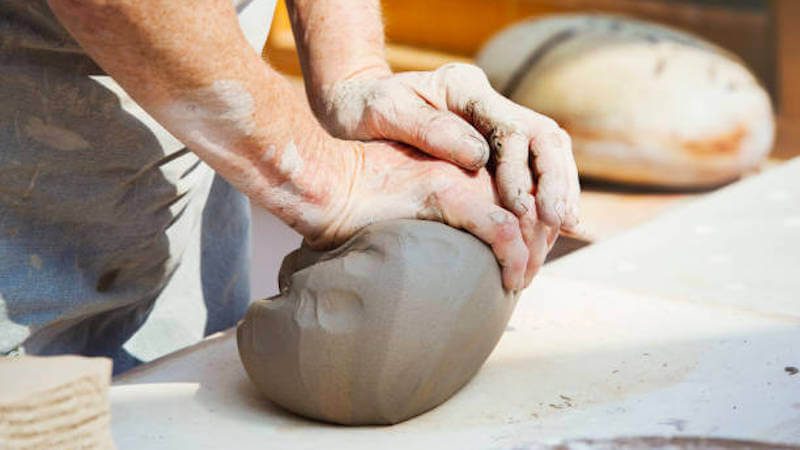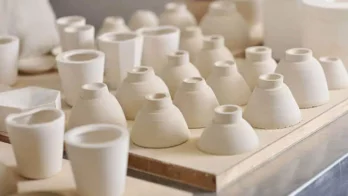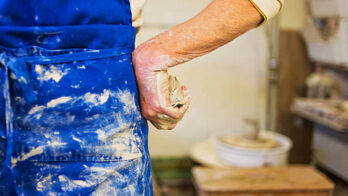Pottery is a fun hobby to take on that can eventually turn into something very fulfilling. Whether you plan on making creations for yourself or selling the pieces to make a living, it is important to learn all the necessary techniques to make each creation it’s very best.
You might wonder what type of clay you need and if wedging clay is necessary. Figuring out these answers will make you more aware of which techniques not only work but work best for you. This is how you develop a pottery style that is unique to you.
Clay Composition and Quality
The type of clay you use can make all the difference when making pottery. Even if you do not opt for a top-tier brand of clay, you should always examine it before you start crafting because this will determine if you should wedge it or leave it be.
Overall, it is a great idea to wedge the clay regardless of what you make, or you could also use a pugmill to get an even texture to the clay. If you have the means to take this extra step, it will ensure better quality and a more satisfying end result. Wedging clay is simply kneading it with your hands to work with it before you begin crafting. This makes it much more pliable.
Wedging is probably unnecessary if you just purchased the clay and it is fairly moist. This is the best type of clay to use if you want to make something quickly without taking many preparatory steps.
However, if you notice the clay lacks moisture or has an inconsistent texture, wedging is definitely recommended. Without wedging, your clay might have air bubbles inside, which can create imperfections in your pottery.
Some clay that is not brand new can still be very moist and ready to work with immediately. This all depends on the general quality of the clay and can have a lot to do with its texture outright.
Once you put your clay on the wheel, you will learn right away if it will be easy to handle or if it will need some wedging. You can take it off the wheel and wedge it to work with it if an inconsistent texture arises.
Inconsistent and Uneven Clay
It is not impossible to work with uneven clay, but it can present you with unexpected challenges when making pottery. If you put this type of clay on the wheel, it will be hard to manage. You will need to keep an eye on the clay to ensure that air bubbles are not forming because this could create cracks once you put it in the kiln to fire. If this happens you might need to recycle your pottery pieces.
You might waste hours of hard work. However, it is worth trying if you have the time to experiment because it will teach you how to work with more challenging clay. Even with wedging, uneven clay is bound to happen at times.
Pay close attention when you begin to coil clay that has not been wedged. The key to making a great coil is for the entire log to be even all the way through. Uneven clay will alter your proportions and can impact the final shape of the pottery you are crafting.
Again, it is not impossible to work with, but an uneven coil limits what you can create. As long as you pay attention every step of the way, you should still be able to create something worth firing in the kiln.


Why is it Important to Wedge Clay?
Clay should be wedged for a variety of different reasons, these include:
Creates an Even Consistency
Clay can be homogenised through the process of wedging, which results in a smooth consistency throughout the entire mass of clay. Because of this, the clay is much simpler to work with, and it also helps to prevent unexpected results.
Mixing the Clay
Wedging can also be used to combine different types of clay. This can be old and new clay of a same form or two separate clay bodies. These methods can also be used to incorporate additives like colorants into the clay.
It Makes the Clay Softer
Even if the clay isn’t losing moisture, it can become stiff or hard if it sits around for a long time. Wedging helps the clay particles align with each other making the clay softer and easier to mold.
Removes Air Bubbles
Clay air bubbles can be removed by wedging. When working with clay, air bubbles can lead to weak spots and other issues, therefore it’s best to avoid them. When fired, a few air bubbles could cause issues as well. There is a good likelihood that air bubbles will need to be removed if clay is reclaimed or recycled.
Conclusion
As you learn more about pottery and all it entails, you will feel confident when trying a new pottery technique. Practice is all it takes to develop the skills necessary to become great at making your own creations. No matter where you want to take the hobby, it is something that will fulfill you and give you a sense of accomplishment.



Enter your email below to get our FREE beginner friendly tips.
By entering your email address you agree to receive emails from Potters Passion. We'll respect your privacy and you can unsubscribe at any time.



